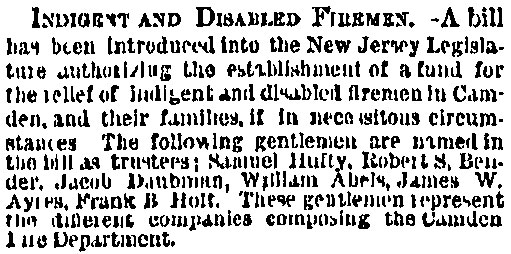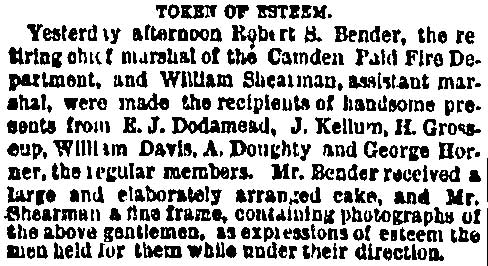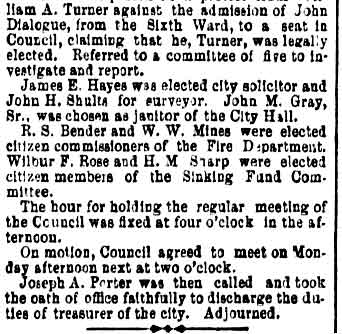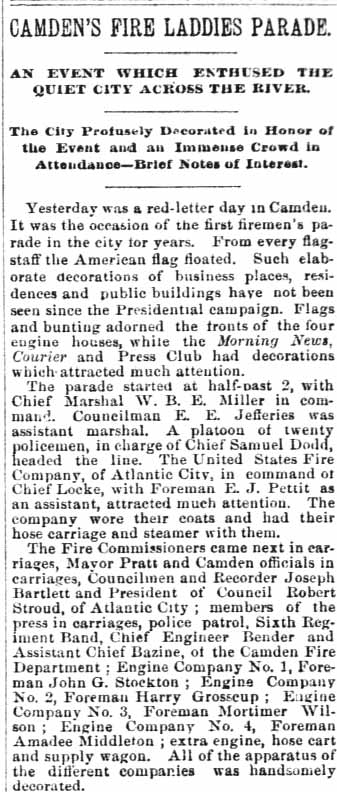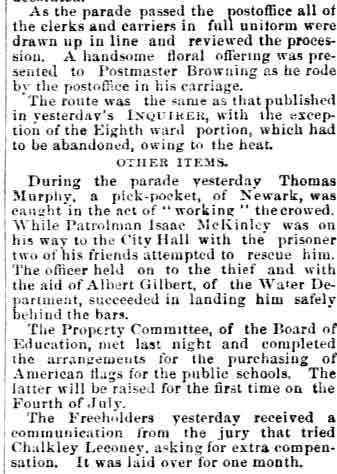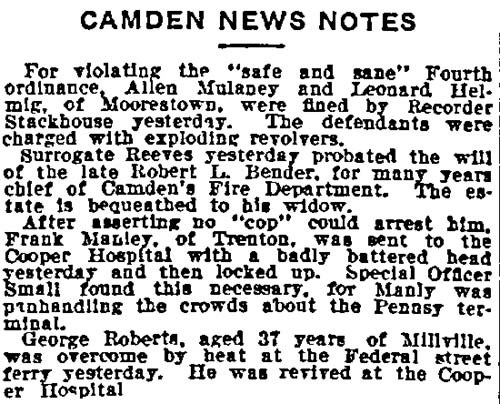|
George
Reeser Prowell wrote about the two companies in his History of
Camden County, New Jersey which was published in 1886.
The
Independence Fire Company No. 1, organized with Lambert F.
Beatty,
president;
William S. Frazer, secretary; and
Joseph
Wagner,
treasurer. Among the early members were Jacob
Prettyman, David Page, Thomas Stites, Andrew
Stilwell, Francis E. Harpel, Restore Cook, John
Wallace, Claudius
W. Bradshaw,
William H.
Hawkins, Christopher J. Mines, Henry Bradshaw,
William E. Walls, William Howard, Albert Dennis, Elwood Bounds,
Samuel
H. Stilwell, Albert
V. Mills, Robert
S.
Bender, Lewis Yeager,
Thomas
McCowan and
William
W. Mines. The company
met in a building at Third Street and Cherry for
a year, when it was burned. Lewis Yeager gave
the company free use of a lot on Third Street,
above
Cherry,
where an engine-house of slabs,
donated by Charles Stockham, was built. In 1853
a lot on
Cherry
Street, above
Third,
was
purchased
and on it a frame house was built. This was
used until 1859, when, owing to a defect in the title, the
sheriff
advertised the property for sale.
When he reached the ground on the day of the
sale he found the house, with its contents, and a number of the
members
of the company, on an
adjoining lot belonging to James B. Dayton, who
permitted the action. The following year, 1860,
they bought and built, on the north side of
Pine
Street, above
Fourth,
a
three-story brick, then the
most complete fire-engine house in Camden, and
which was sold for four thousand five hundred dollars to the
city. The
Independence was a
hose
company until June 4, 1864, when they secured an
Amoskeag engine, being the first fire-engine in
use by the fire companies of Camden. Early in 1869 they
purchased a
larger engine and when
the volunteer firemen were scattered, in the latter
part of that year, they sold the Amoskeag to Millville, and the
later
purchase was kept until 1874,
when it was sold to the city. Lambert F. Beatty, John Wallace,
William H.
Hawkins, J.
Kelly
Brown, William
W.
Mines
and Edward Gilbert were presidents of the Independence, while
its
secretaries have been
William L. Frazer,
William
W.
Mines, Mortimer C.
Wilson and Thomas
McCowan ; and the treasurers
Joseph
Wagner and
Robert S.
Bender,
who,
elected in 1854, served until October 13, 1874,
when, with a roll of sixty members, they met.
President Gilbert in the chair, paid all claims
against them and formally disbanded.
After the Civil War, Robert
Bender was one of the original members of the Camden Fire
Department,
entering service on December 7, 1869 as as extra man of
the
Hook
& Ladder Company, the
original designation of what is now
Ladder
Company 1.
In business as a bookbinder, he made his home at 223
Federal
Street when he joined the
department in the fall of 1869. Robert Bender had served as a
volunteer fire fighter with the Independence Steam Engine Fire
Company in the years leading up to the formation of the paid
department, as did his employee,
Thomas
McCowan,
who also was an original member of the Camden Fire Department.
Other Independence men included
Thomas
Allibone, William
W. Mines, Christopher Mines Jr., and
Claudius
Bradshaw.
Allibone
and William W.
Mines
became original Camden Fire Department members
Claudius
Bradshaw later served as Chief of the Department and as
Mayor, and Christopher Mines was at one time Camden County
Sheriff.
About
5 P.M. on Saturday, July 18, 1868 flames were discovered coming
from the engine room of Goldey & Cohn's large box factory on
Taylor
Avenue. Flames spread through the building, feeding on
the
highly
combustible stock. The entire building was soon engulfed in fire
as was
the late R.H. Middleton's brick stable. A brisk southwest wind
carried
the flames across
Taylor
Avenue to the company's lumber pile and onward to
Middleton's
warerooms at #7
South
Second
Street and also his two and one-half story
frame dwelling at #5
South
Second
Street.
Chief
Engineer Ayers realized that additional help was needed and
telegraphed Chief McClusker of Philadelphia for assistance. The
blaze
was already threatening to consume the most densely populated
and most
valuable section of the City. Chief McClusker responded with
steamers
from the Vigilant and Hibernia Fire Companies, the Fairmount,
Lafayette,
Neptune, America and Diligent Hose Companies and the Empire Hook
&
Ladder Company.
As
the firemen placed the steamers along the Delaware River and
laid their
hose lines, the fire spread to the Ware & Marshall meat and
provision store, a two story brick property at #3
South
Second
Street
and to a two and one-half story brick dwelling at #1
South
Second
Street
(owned by Joab Scull and occupied by Charles Armstrong). These
buildings
were destroyed as was Joab Scull's wood frame grocery store on
the
southwest corner of Second and
Federal
Streets and an adjacent three story brick dwelling (also
owned
by
Scull but occupied by Mr. Goldey).
The
fire continued to spread destroying Mr. Test's frame drugstore
and
extending to the home of
James M.
Cassady, Esquire's house at 128
Federal
Street. Firemen were successful in saving Cassady's
residence
from
complete destruction. Although the property sustained heavy
water
damage, only the rear of the building was destroyed. The fire
fighters
continued their determined stand against the oncoming flames and
were
able to save the property of the late Samuel McLain which
adjoined
Cassady's residence.
Conrad
Hoell's saloon at the corner of Second and
Federal
Streets and the adjoining building occupied by L.G.
Peterson
ignited
several times, but the flames were quenched by what the West
Jersey
Press called the "superhuman exertions" of the fire
fighters.
Several
firemen were overcome by the intense heat, including Captain
Wesley P.
Murray and Joseph Flanigan of the Weccacoe Hose and
Robert
S. Bender,
Thomas
McCowan and
Thomas
Allibone of the Independence Steam Engine. These men had
to be
removed from the scene.
Combined
losses exceeding $54,000 were reported as a result of this
devastating
conflagration. Chief Engineer Ayers praised the efforts of his
men and
the good work done by Chief McClusker and his forces from
Philadelphia.
The grateful citizens joined in this praise.
On
the afternoon of Monday; September 14, 1868 about 2 P.M.
Camden's
volunteers along with others from Philadelphia were called to an
inferno
at the Washington Manufacturing Company in Gloucester City. This
huge
blaze caused a half million dollars in losses and destroyed hose
belonging to the Weccacoe and Shiffler Hose Companies of Camden.
Both
companies received compensation for the damaged hose from the
owners of
the manufacturing firm.
THE
INCEPTION OF THE PAID DEPARTMENT
Rivalry
and frequent insubordination in the volunteer department led to
its
demise. An example of these problems can be found in an article
in the
West Jersey Press on September 23, 1868:
"The
discordant elements belonging to the Independence and Shiffler
fire
companies have found a common ground of compromise and settled
upon it
as we learned from Chief Murray. Hereafter, we are to have no
more
bricks and paving stones flying around loose. Let us have peace,
long
and enduring."
As
a case in point, someone had cut the Independence Fire Company's
hose
during the Nickel Works fire and a $50.00 reward had been
offered for
the identity of the culprit(s).
Still,
the citizens supported their volunteers and vehemently opposed
the
creation of a paid department. The community-at-large was proud
of the
service rendered to them by the volunteers and leery of the
costs
involved to create and maintain a paid force. The proposed
downsizing of
the department to only five pieces of apparatus and forty-one
members
was another cause for concern. Numerous meetings were held and
many
articles appeared in news-papers expressing concerns about, and
opposition to, the paid department.
|
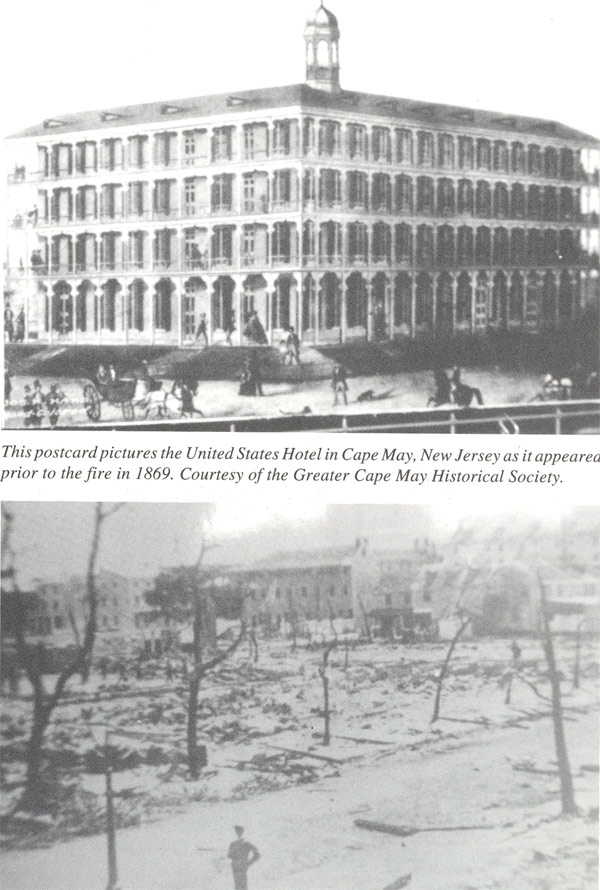
|
|
This
early photo shows the devastation which
resulted
from the
disastrous blaze at the United States Hotel
in Cape
May. The
fire occurred on 8-31-1869. Courtesy of the
Greater
Cape May
Historical Society.
|
Had
the smaller paid department existed on August 31, 1869, Camden
would not
have been able to provide the much needed manpower and equipment
to Cape
May, New Jersey. On that day a conflagration threatened this
shore
resort at New Jersey's southern most tip. An urgent call was
received
from the City of Cape May during the early morning hours.
A
huge blaze, involving the famous United States Hotel and many
other
hotels, businesses and residences was burning out of control.
Chief
Murray dispatched the Shiffler and Independence steamers with
2000 feet
of hose, the hook and ladder from the United States Fire
Company, and
manpower with apparatus from both the Weccacoe Engine and Hose
companies
to the Cape May fire. These units from Camden were sent 90 miles
by
special train where they "rendered gallant and efficient service
in
extinguishing the raging flames". Camden's citizens were proud
that
they could provide valuable service to neighbors in need, yet
maintain
adequate fire protection at home. This was something the
proposed, much
smaller paid department would not have been able to do.
Despite
opposition, on September 2, 1869 City Council enacted a
municipal
ordinance creating a paid fire department. It provided for the
annual
appointment of five Fire Commissioners, one Chief Marshal (Chief
of
Department) and two Assistant Marshals. The City was also
divided into
two fire districts. The boundary line ran east and west,
starting at
Bridge
Avene and following the tracks of the Camden and Amboy
Railroad
to the city limits. District 1 was south of this line and
District 2 was
north. The commissioners also appointed the firemen who were
scheduled
to work six 24 hour tours per week.
William
Abels, from the Weccacoe Hose Company No. 2 was
appointed Chief
Marshal with William
J.
Mines,
from the Independence Fire Company No. 3 as Assistant Marshal
for the
1st District, and
William
H.
Shearman as the Assistant Marshal for the 2nd District.
Abels
had served with the volunteer fire departments of Philadelphia,
Mobile,
Alabama and Camden for sixteen years prior to his appointment as
Chief
of the paid force.
On
the morning of November 9, 1869 a fire destroyed nine frame
dwellings at
Cooper's Point. Many of the occupants narrowly escaped death as
flames
spread rapidly. One resident, Mr. Elliot, was badly burned as
were two
of his children. His wife and mother were injured while escaping
the
flames. The steamer of the Weccacoe Hose Company overheated due
to lack
of water in the boiler and had to shut down. Steamers from the
Weccacoe
Engine Company and Shiffler supplied the hose streams that
battled the
blaze. An adjacent lumber yard owned by Perry & Packer was
spared
due to the efforts of firemen.
On
November 10, 1869 City Council purchased the Independence
Firehouse, the
three-story brick building at 409
Pine
Street, for $4500. The building was designated to serve
as
quarters
for Engine Company
1
and the 1st District. On October 29, 1869 City Council
authorized
construction of a two-story brick building on the northwest
corner of
Fifth
and Arch
Streets as quarters for
the 2nd District. On November 25th the Fire Commissioners signed a
contract with M.N. Dubois in the amount of $3100 to erect this
structure. The 2nd District would share these quarters with
Engine
Company 2 and the
Hook
& Ladder Company and
the facility would also serve as department headquarters for the new
paid force. The original contract remains part of the Camden County
Historical Society collection.
|
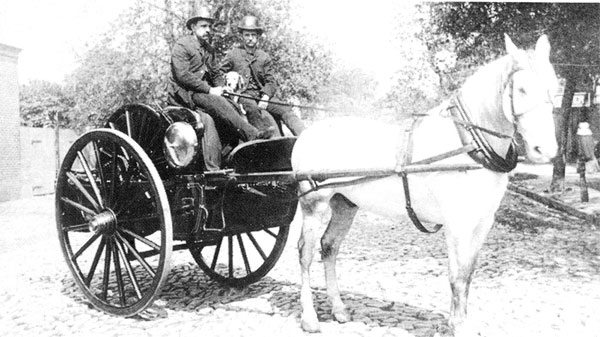
|
|
Engine
Company 2 with 1869 Silsby Hose
Cart. Photo
Circa 1890. Note
badges upon derby hats worn by Fire
Fighters.
|
Two
Amoskeag second class, double pump, straight frame steam engines
were
purchased at a cost of $4250 each. Two Silsby two wheel hose
carts, each
of which carried 1000 feet of hose, were another $550 each and
the hook
& ladder, built by Schanz and Brother of Philadelphia was
$900. Each
engine company received a steam engine and hose cart. Amoskeag
serial
#318 went to Engine
Company 1, and serial #319 to
Engine
Company 2. The Fire Commission also secured the services
of the
Weccacoe and Independence steamers in case of fire prior to
delivery of
the new apparatus. Alfred McCully of Camden made the harnesses
for the
horses. Camden's Twoes & Jones made the overcoats for the
new
firemen and a Mr. Morley, also of Camden, supplied the caps and
belts
which were manufactured by the Migeod Company of Philadelphia.
The new
members were also issued badges.
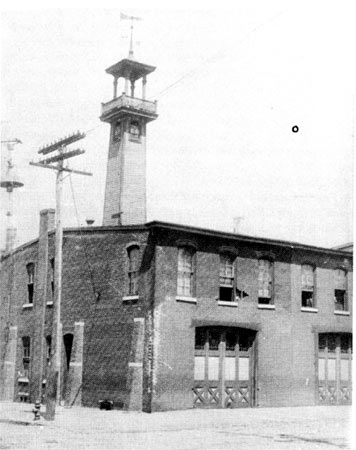
|
This
is the earliest known photo of fire headquarters
on the
northwest corner of
Fifth
and
Arch
Streets. Originally built in 1869, the
building
shows signs
of wear some twenty years later. Note the
weathervane
shaped
like a fireman's speaking trumpet atop the
tower. Also,
the fire
alarm bell is pictured to the left of the
telegraph pole
above
the rooftop. The bell was removed from the
building once
the
fire alarm telegraph system was expanded and in
good
working
order.
|
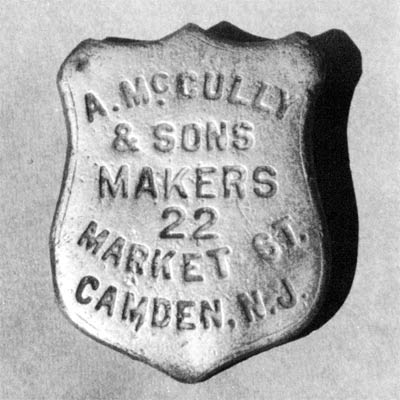
|
This
maker's plate once was attached to a harness
made by
A. McCully
& Sons, 22 Market Street, Camden, New
Jersey.
This firm
provided the first harnesses for the paid
fire
department in
1869.
|
Badges
worn by the marshals, engineers, stokers and engine drivers bore
the
initial letter of their respective positions and their district
number.
The tillerman and his driver used the number "3" to accompany
their initial letter. The extra men of the 1st District were
assigned
badges 1-10; 2nd District badges were numbered 11-20 and the
extra men
of the hook & ladder wore numbers 21-30.
Although
the Fire Commission intended to begin operation of the paid
department
on November 20, 1869, the companies did not actually enter
service until
December 7th at 6 P.M. because the new apparatus and buildings
were not
ready. The new apparatus was not tried (tested) until December
9th.
The
new members of the paid force
were:
|
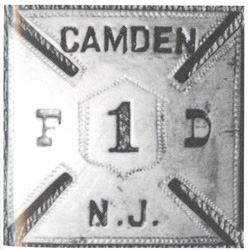
|
The
first style of breast badge worn by members
of the
career
department in the City of Camden. 1869.
(Courtesy of
the
C.C.H.S. Collection).
|
Charles
G. Zimmerman was the
brother-in-law of Chief Abels, married to the
Chief's sister
Keturah. Charles
G. Zimmerman's brother
Theodore
Zimmerman also was a charter member, serving
with
engine company
2.
Thomas
McCowan was an employee
of Robert S. Bender, and lived with the Bender family at 223
Federal
Street.
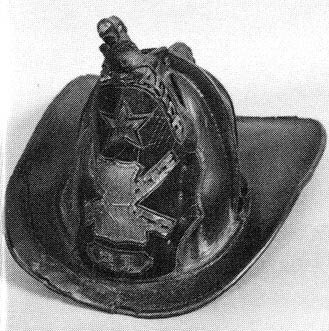
|
Leather
helmet of natural grain believed to have
been worn
by Fireman
Charles Baldwin,
Hook
& Ladder Company 1 when paid
force was
organized in
1869. Number 21 at bottom of frontpiece
indicates
member's badge
number. (Courtesy of the Camden County
Historical
Society
Collection.)
|
The
Board of Fire Commissioners consisted of Rudolphus Bingham,
Chairman and
Samuel C. Harbert, Richard Perks, Jonathon Kirkbride and Jacob
Daubman.
Annual
salaries for the members of the paid force were: Chief Marshal,
$800;
Assistant Marshal, $200; Engineer, $600; Driver, $450; Stoker,
$450;
Tillerman, $450; Extra Men, $50. All but Extra Men were paid
monthly.
Many
members of the newly organized paid department were former
volunteers
and had distinguished themselves as leaders through their
dedication and
hard work.
In
October 1869, the Independence sold its newer carriage to the
City of
Rahway, New Jersey for use by its Washington Fire Company. Two
months
later, Independence sold its first Amoskeag steamer and old hose
carriage with 800 feet of hose to Millville, New Jersey. In May
1871,
Millville sold the steamer to the Friendship Engine and Hose
Company
No.1 of Chambersburg, Pennsylvania. The steamer remained in
service
until 1911 and was scrapped the following year. The Independence
Firehouse had been purchased by the City of Camden as quarters
for
Engine Company 1 of the new department.
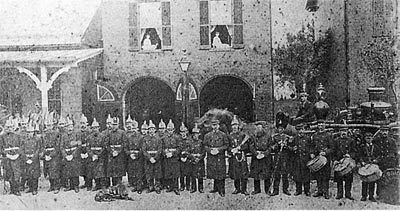
|
Photo
taken 5-20-1871 in front of
the
Friendship Engine &
Hose Company No.1 of
Chambersburg,
PA. The steam engine
on the right has just
arrived after
being purchased from
Millville, N.J. This
apparatus was
originally purchased
by the Independence Fire
Company
No.3 of Camden in June
1864. It was a class two
Amoskeag
steamer
bearing
|
|
serial
No. 92. Independence sold the
apparatus
to Millville in
1869
|
|
In
December 1873 Independence offered to sell its second class
Gould steam
engine to the City for $1200. The engine had cost $5250 when
built in
1869. A short time later City Council accepted the offer.
Independence
disbanded on October 13, 1874 with a membership of sixty men;
Edward
Gilbert was
President.
Department
records indicate that on Thursday night, December 30, 1869 the
paid
force responded to its first fire at the R.M. English &
Company
oil-cloth
factory at Cooper's Point. The plant only recently had begun
operation.
The paid firemen performed admirably under the direction of
Chief
Marshal William
Abels.
Although one of the main buildings was destroyed, the fire
fighters were
able to limit damage to the other buildings. The blaze, which
resulted
in a loss of $30,000, was thought to have been caused by a
defective
flue.
The
second major fire to confront the new department occurred on
Christmas
morning, 1870. Fire destroyed
St.
John's Episcopal Church at
Broadway
and Royden
Streets. The church had once been a floating chapel for
seamen
on
the Delaware River. Within an hour the church burned to the
ground.
Several years later, in 1892, the new church building would also
be
destroyed by fire.
City
Council and contractor Abraham Lower entered into a contract on
May 16,
1870 that called for Lower to erect a brick stable adjoining the
quarters of Engine
Company 1 at 409
Pine
Street. The contract amount was $1650. The original
contract
remains
the property of the Camden County Historical Society.
William
Abels was politically active, however, he ran into some
legal
difficulty
in January of 1871 involving a dispute over a glass factory
purchased by
then Sheriff Randall Morgan.
William
Abels served as Chief Marshal until his replacement on
September
2,
1871. City Council appointed Robert S. Bender as his successor
while the
Assistant Marshals remained the same. Robert S. Bender had been
working
as Camden City's coroner as recently as June of that year. He
did both
jobs until turning it over to his newly elected successor, Dr.
James A.
Armstrong, On November 28, 1871.
On
Wednesday, November 29,1871 about 6 P.M. a watchman discovered a
fire at
the Kaighns Point works of
Dialogue &
Wood. Within seconds the blaze
engulfed the machine, pattern and blacksmith shops. Fortunately,
a gale
force wind from the northwest helped keep the flames from
spreading to
the main building. Camden Firemen pressed an all out attack with
all
companies in service, but the blaze resulted in a $70,000 loss.
The
Fire Commission purchased a hose carriage for $60.00 from the
Philadelphia Fire Department on January 24, 1872. The carriage
had been
on loan to Camden and was used while Hose Cart 2 was being
repaired.
This purchase enabled Camden to maintain a reserve hose
carriage. In
1872 the Camden Fire Department consisted of forty-one members
and seven
horses. There were one hundred and fifteen fire hydrants in the
city; a
list hydrants, giving both hydrant number and location, was
posted in
each firehouse.
A
serious fire occurred at Cooper's Point on February 28, 1872.
The fire
originated in a furnace in the spare shed of a Mr. Humes and
spread
rapidly to the boat shop of Butler & Cullings. Several
dwellings
were also damaged by flying embers. The fire fighters utilized
fire
extinguishers that been had been given them by the Gardner Fire
Extinguisher Company. Camden members were assisted by firemen
from the
Camden & Atlantic Railroad who responded with their Babcock
fire
extinguishers. This fire was the worst to occur since the blaze
at
English's oil cloth factory.
On
the Fourth of July, 1872, a fire damaged properties at 34,36,38,
and 44
South
Fifth
Street below
Market.
The entire Department responded before
the blaze could be brought under control.
Later
that month the Department implemented a signal system for
communications
between fire stations. A red flag was used during daylight hours
and a
red light at night. Now one firehouse could inform another of a
fire
alarm without ringing the bells in the tower. Too many false
alarms had
resulted when church bells were mistaken for fire bells.
The
first signal station (fire alarm box), made of wood, was located
at West
and Berkley Streets, South Camden, and midway between the two
firehouses. An agent of the American Telegraphic Fire Alarm
Company went
before City Council on May 30, 1872 to propose a municipal fire
system
as follows: A series of wires would connect the quarters of
Engine
Company 2 (Fire HQ) with Coopers Point, the woolen
mills,
Starr's
Foundry, Kaighns Point and twelve more remote areas of the
Seventh Ward
in Camden. Twenty-five pull boxes would be placed in convenient
locations and would transmit the alarm to both firehouses. The
ten miles
of cable also would enable the Chief Marshal to telegraph for
assistance. The estimated cost of the system was a few thousand
dollars
with annual maintenance costs at two to three hundred
dollars.
Chief
Abels was
replaced
by Robert S.
Bender
as Chief of the Fire
Department on September 2, 1871. When Bender took a
leave of absence in September of 1872, despite a petition for
him to be
kept on as chief,
Henry
F. Surault was
elected by city council to
lead the department. Patrick Gallagher and
Isaac
McKinley were appointed Assistant Chiefs,
replacing
Assistant Chiefs
William
W. Mines and
William H.
Shearman. A greater crisis occurred on October 8, 1872
when most of the regular members members of
Engine
Company 2 resigned at once. Replacements were found
quickly,
although in a
few cases the first ones brought in did not work out and another
man was needed to replace the original replacement.
John
J. Olden was also brought in as Assistant Chief of the
Second
Fire
District in November, replacing Patrick Gallagher.
On
a positive note, during
his time in the Department
Henry F.
Surault
convinced the Fire Commission to
purchase hand extinguishers which he then placed strategically
at Mr.
Paul Anderson's, Broadway and Kaighns Point Avenue; J.S. Henry's
office at
Eighth
and
Walnut
Streets; William Ross' store on Central
Avenue; and at the
Flat Iron
Tavern
(and Hotel) at
Broadway
and
Ferry
Avenue.
Each location received one fire extinguisher.
A
devastating fire began on the morning of February 24, 1873 when
railroad
employee dropped a match in the inspector's room of a railroad
building
on second
street below
Bridge
Avenue. Within minutes the oil soaked
floor ignited and flames engulfed the structure. Strong
northwest winds
extended the fire to a storage shed filled with freight.
Responding fire
companies could not stop the rapidly spreading fire. Five frame
dwellings on the north side of Weatherby's Court, some sheds in
the
railroad car yard, three frame dwellings on Reed's Court, two
additional
dwellings and numerous outbuildings became involved. Chief
Surault
telegraphed to Philadelphia for six engine companies which
responded by
special ferry. Three apparatus were placed in service while the
balance
of the manpower was used for fire control.
On
May 28, 1873 City Council enacted an ordinance that reorganized
the
Fire Commission to consist of three members of Council, two
citizens,
the Chief Engineer, one Assistant Engineer, and one Secretary to
be
elected on July 1st of each year. The annual salaries for
members of the
Uniformed Force were to be: Chief, $800; Assistant, $200;
Foreman, $100;
Engineer, $660; Drivers, Stokers, and Tillermen $560 and Extra
Men
$50.
Benjamin
Cavanaugh became the Department's first Foreman on June 3,
1873, the
day
before Samuel
Buzine was promoted to the rank of Assistant Chief
Engineer.
At
the Council meeting of December 1873 Chief Engineer Robert S.
Bender
recommended that the City purchase the second-class R.J. Gould
steam
engine owned by the Independence Fire Company. This apparatus ha
a
double vertical pump and a boiler lined with copper flues to
prevent
rust and had seen service only two or three times in the spring
of 1869.
Chief Bender wanted this engine held in reserve at headquarters
until
the spring of 1874 when he planned to organize another district
and fire
station in the lower half of the city. He felt the expansion was
necessary since a large number of factories, lumberyards and
shipyards
had recently been built there. A new engine company would reduce
response time and prevent fires from gaining headway before
additional
help could arrive. Although the new firehouse was not built
until 1890,
the Gould engine was purchased and placed in reserve. It was
removed
from service in 1902.
The
nation's Centennial Year found the Democrats gaining control of
City
Council. On April 8, 1876
Claudius
W. Bradshaw was elected Chief Engineer.
When
the Census was taken in 1880 Robert Bender was living at 225
Federal
Street, next door to
Thomas
McCowan, who lived at 223
Federal.
McCowan was working as a watchman, while Robert Bender was
employed as a
collector. He would in time return to his bookbinding
business.
Three of the Bender's four children were living at home at that
time, C.
Emma, H. Jennie, and Robert Louis Bender. Daughter Emma Bender
lived
elsewhere.
Robert
S. Bender was re-elected Chief Engineer in 1888, succeeding
Samuel
S. Elfreth. He retained Elfreth's officers. This was
Robert
Bender's
third tenure as Chief.
In
December of 1888 the Whitney Brothers Glass Works burned for the
fourth
time. On My 29th of the following year a night watchman
discovered still
another fire at the Glass Works. Box 31 at Front Street and
Kaighn
Avenue was received at 5:15 A.M. The blaze, caused by an
overheated
furnace, threatened C.B. Coles' lumberyard before being
contained. Loss
was $2500.
At
the meeting of September 4, 1889 the Fire Commission approved
the
purchase from Joseph Franklin of property at 320
Vine
Street in North
Camden
as the site for a new fire station. The cost was $5000 for this
50 x 100
foot property. A three-story home on the site had to be razed.
At this
same meeting approval was given to purchase a lot at 1813
broadway
for $1600. Firehouses for new units were erected at each
location.
On
June 1, 1890 Engine
Company 3 was organized on
broadway
near Ferry
Avenue
in what was the Camden's Eighth Ward.
Their apparatus was a second class Clapp & Jones steamer
(maker's
plate #527) and a Button hose carriage, each drawn by two
horses. The
company's roster included
Mortimer
Wilson as
Foreman,
Samuel Lodge
as
Engineer, Joseph
Reed
as Stoker,
William Deno
as
Driver, and hosemen
George W.
Shields
and John
Ware.
On
the same day, Engine
Company 4 entered service at
Vine
Street, North
Camden
with a two-hitch second class Button steam engine and a
one-hitch Button
hose carriage. The company Foreman was
Amedeee
Middleton; Engineer
Francis
Turner;
Stoker, Barney
Harvey; Driver,
Edward
Hartman; and hosemen
Walter
W. Browning,
Charles
Berry.
Also
on that day Driver
Benjamin
Kellum was promoted to become
Ladder Company
1's first foreman.
In
early May, 1891
Samuel
S.
Elfreth replaced Robert S. Bender as Chief Engineer.
Robert
Bender
returned to civilian life and his bookbinding business. Robert
S. Bender
resided at 25
Broadway
from 1888 through 1895. The 1896 City Directory shows him at 725
Market
Street. He lived at 27
Broadway
in 1897 and 1898. Robert S. Bender was living at
56 Penn
Street when the census was taken in 1900. By 1906 he had
moved
to 107
Penn
Street. In 1886 George Reeser
Prowell wrote the following concerning Robert Bender's business:
Blank
and Printed Book Bindery.— This business was first established in
Camden by Jacob Bender, in 1850, at the southwest corner of Third
and
Arch Streets. In 1856 the location was changed to No. 223
Federal
Street, when the entire business was sold out to his son,
Robert S.
Bender, who continued in this place until April, 1885. The bindery
was
then removed to No. 101
Market
Street. Job binding and printed matter of
all descriptions is executed, and the bindery is most complete in
the
necessary machinery for the purpose. A Davey safety engine and
boiler
furnishes the motive-power for the folders, stitchers, cutters,
stamping
presses, etc. Five workmen, five girls and five boys are
employed.
Robert
S. Bender was still in business as a bookbinder when the census
was
taken in 1910.
He then was living with his wife Jane Bender at 107
Penn
Street. Three of the Bender's four children were then
living,
although none were then at home.
Robert
Bender was involved in at least three fraternal organizations in
Camden,
Pontiac Tribe No. 134 of the
Improved
Order of Red Men, the Eureka Council of the Legion of
the Red
Cross,
and the Independent Order of Mechanics Excelsior Lodge, No
9.
Excelsior Lodge, No
9, was
organized in Lincoln Hall, August 22, 1884, by Grand Officers
Ellis W.
Wolverton and Joseph Louder, assisted by members of Enterprise
Lodge,
No. 3, when these were initiated:
Robert S.
Bender; George M. Wolfe,
William Shutt, John N. Noll, Edward Shuster, John Folwell, Sr.,
Amos
Carrow, Albert Shinn, Jacob Green, Phineas Ash, William Fisher,
Bowman
Marshall, Edward L. Countiss, William S. Wolfe, Abraham Foust,
Robert M.
Laconey, Benjamin H. Thomas, Thomas Hickman, Edgar B. Slifer,
Robert N.
Bollevow, John Owens, Robert Gibberson, George Smith, Frank
Marshall and
Harry W. Sutton. The officers chosen were: S.M., Robert S.
Bender;
Treasurer, John N. Noll; W.M., William S. Wolfe; R.S., Abraham
Foust;
J.M., Edward Shuster; F.S., Robert M. Laconey. The lodge
prospered
and in 1886 numbered three hundred and fifteen members, with
assets
amounting
to seven hundred and twenty-three dollars. The meeting-place was
changed
to Independence Hall,
Fourth
and
Pine
Streets. The Past Worthy
Masters are Robert
S.
Bender, William S. Wolfe, George M. Wolfe,
Leonhard Boehm, Thomas Locke, William Bell and David Ewan. The
officers
for 1886 were: W.M., Thomas Ainsley; F.S., George M. Wolfe;
S.M., James
Carnan; Treasurer, John N. Noll; J.M., David Ewan; Chap., Edgar
Slifer;
R.S., Abraham Foust; Con., Frank Seeds..
Robert
Bender passed away July 10, 1913 and was buried at Harleigh
Cemetery.
Many
years after Robert S. Bender passed away, another Camden Fire
Department
member, George
Smith,
lived at 107
Penn
Street.
|
